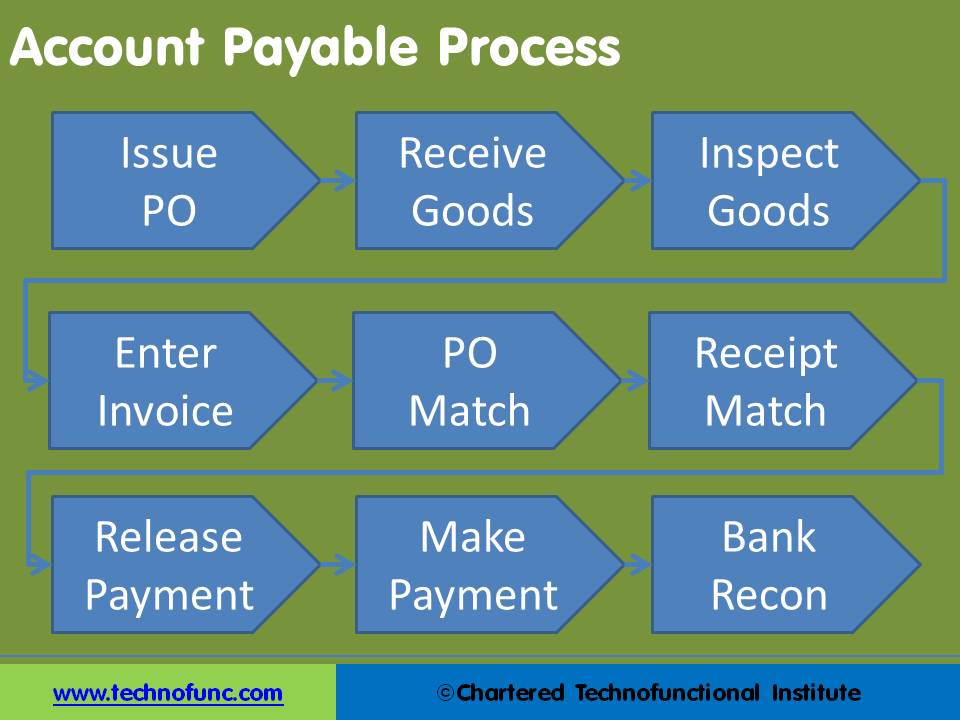- Home
- Business Processes
- Industry Knowledge
- Aerospace Industry
- Automotive Industry
- Banking Domain
- BFSI Industry
- Consumer/ FMCG Industry
- Chemicals Industry
- Engineering & Construction
- Energy Industry
- Education Domain
- Finance Domain
- Hospitality Domain
- Healthcare Industry
- Insurance Domain
- Retail Industry
- Travel and Tourism Domain
- Telecom Industry
- Leadership Skills
- eLearning
- Home
- Business Processes
- Warehouse Management
- Account Payable Process
Account Payable Process
Understand the Accounts Payable process. Understand the AP cycle and the various tasks that need to be completed during AP transaction processing. Learn the key activities and setups that are done in any typical system during the AP processing.
Given below is the complete Accounts Payable Process:
1. Issue Purchase Order:
The AP Process starts with the issue of Purchase order to the Supplier. The purchase order specifies what you intend to buy, the make and the quality of the goods. In some cases it also specifies the agreed quantity and the price.
2. Receive Goods:
Based on the purchase order the supplier will ship a product. Till goods have been received by the customer, the ownership generally lies with the supplier. Once the goods are received at your go down, you become the owner of the goods.
3. Inspect Goods:
Most organizations have the internal control processes to inspect the goods to ensure the quantity and quality of the supplied material.
4. Enter Invoice:
Supplier issues an credit invoice, and collects payment later. This describes a cash conversion cycle, a period of time during which the supplier has already paid for raw materials but hasn't been paid in return by the final customer. Received invoice is accounted for in the books of the customer.
5. PO Match and Receipt Match:
When the invoice is received by the purchaser it is matched to the packing slip and purchase order, and if all is in order, the invoice is paid. This is referred to as the three-way match. The three-way match can slow down the payment process, so three-way matching may be limited solely to large-value invoices, or the matching is automatically approved if the received quantity is within a certain percentage of the amount authorized in the purchase order.
6. Release and Make Payment:
Once the matching is done and accounts payable department is satisfied to the accuracy and validity of purchase, the refer to the payments terms. Companies may have negotiated different payment terms with different suppliers. Payment is released based on the agreed payment terms and amount is issued to the supplier.
7. Bank Reconciliation:
Generally the payment is made through the bank. There is a slight delay between the date when the payment is released and when it reaches to the account of the supplier. The bank entry is reconciled to the original payment entry in the Payments Register to reconcile the both accounts and this completes the account payable process.
In the next video tutorial we will take you through the accounting entries in the payable process.
Given below are some other activities that happen during the AP processing cycle:
- Define and maintain supplier information to be used at the time of invoicing and payment
- Enter invoice information
- Match invoices to Purchase Orders
- Define, enter and import employee expense reports as expenses are also part of payables to employees
- Set up bank accounts for payment to Vendors
- Enter manual payments or use EDI to make automated payments
- Pay invoices
- Stop and void payments in case any holds are required
- Enter and apply prepayments to invoices, adjust advances
- Enter and apply employee advances
- Create recurring invoices for same type of invoices
- Transfer invoices and payment details to General Ledger to ensure proper accounting
- Before any ERP System works, you might need to define the tax defaulting rules and principles

Related Links
You May Also Like
-
One of the most important decisions when running a warehouse is its layout. Warehouse layout defines the physical arrangement of storage racks, loading and unloading areas, equipment and other facility areas in the warehouse. A good layout aligned with the business needs could have a significant effect on the efficiency.
-
Warehouse management and distribution logistics involve the physical warehouse where products are stored, as well as the receipt and movement of goods takes place. Warehouse management aims to control the storage and movement of products and materials within a warehouse. These operations include the receipting of inwards goods, tracking, stacking and stock movement through the warehouse.
-
Accounts Payable Journal Entry
Although in the large organizations the Procure to Pay Accounting process starts when the purchase order for supply of goods is released to the supplier. To keep things simple in the beginning we will discuss the core accounting entries related to the Accounts Payables process.
-
Business Case of Multiple Warehouses
Adding extra warehouses to business provides many benefits such as reducing shipping costs, increasing storage capacity, and having warehouses for specific purposes to simplify overall warehouse management. Multiple warehouses allow you to organize your inventory in a way that helps your business be more effective.
-
At a high level, the essential elements in a warehouse are an arrival bay, a storage area, a departure bay, a material handling system and an information management system. As part of the process for enabling a warehouse layout, you must define warehouse zone groups, and zones, location types, and locations.
-
Types of Order Picking Methods in the Warehouse
There are many different types of picking in a warehouse and each one works as a customized solution for each business. Depending on the size of your warehouse and inventory, the manpower you have on hand, and the number of customer orders made each day, there may be certain methods that are more efficient for you than others.
-
This article discusses the key documents that gets generated during the import/export process. These documents may apply to both invoice to cash as well as order to cash cycles. Also learn the major custom docments for India.
-
Inventory is money, and hence businesses need to perform physical inventory counts periodically to make sure that their inventory records are accurate. The traditional approach to conducting inventory counts is to shut down a facility during a slow time of year to count everything, one item at a time. This process is slow, expensive, and (unfortunately) not very accurate.
-
What is the difference between Warehouse Management & Inventory Management?
The terms “inventory management” and “warehouse management” are sometimes mistakenly used interchangeably as they both deal with operations and products of industries. Despite their few similarities, there are many notable differences between warehouse and inventory management systems.
-
In the normal course of business, customers are likely to return orders from time to time due to various reasons and business should design processes the manage and accept such returns. A well designed returns management process can reduce costs and issues associated with returns or exchanges.
Explore Our Free Training Articles or
Sign Up to Start With Our eLearning Courses

About Us
Learning
© 2023 TechnoFunc, All Rights Reserved










